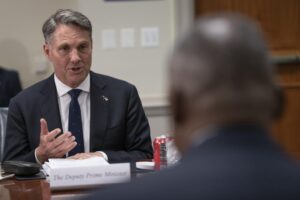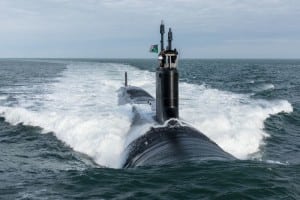Australia’s defense minister this week said he hopes the AUKUS agreement will help break barriers to create a “seamless” defense industrial base among the U.S., U.K. and Australia as they work to help Australia develop a new nuclear-powered attack submarine.
In meetings with U.S. officials “we’ve been specifically talking about how we can have our defense industrial bases operate in a more seamless way. And, again, we’ve been met with really good responses in respect to that,” Deputy Prime Minister and Defense Minister of Australia Richard Marles told reporters during a Defense Writers Group event on July 14. Marles was in Washington, D.C., for the week in his first official visit in his new role in Australia’s new administration.
Marles said at the high policy level he has found an acceptance about wanting to integrate industrial bases with a sense of shared mission, but both sides understand there is much more work to be done to allow that.
“Getting to that point would reflect, I think, where we’re at with interoperability, almost interchangeability, that we see within our militaries and our defense forces. There is, though, a lot of work to be done at a more micro level to turn that policy to reality. And again, I think, you know, we’re mindful of that, I think America is mindful of that as well, that’s the agenda that we’re going to be working with.”
Last September, the U.S., U.K. and Australia announced the AUKUS partnership to help Australia procure a new class of nuclear-powered attack submarines to replace its current fleet of six conventional diesel-electric-powered attack submarines. That deal also has Australia cancel a previous plan to buy 12 new conventionally-powered submarines designed by France’s Naval Group (Defense Daily, Sept. 15, 2021).

Initially, the countries are undergoing an 18-month exploratory review period to help inform the Australian government on how to pursue the capability.
Marles acknowledged restrictions in U.S. export control rules have hampered more connections between the two countries’ industrial bases in the past.
“We need to see a breaking down of barriers across all three countries, in terms of developing a more seamless industrial base, across the three countries and it would be fair to say that the achievements and aspirations of AUKUS are going to be tied up significantly with our success or not in being able to break down those barriers.”
Marles noted export control barriers are not exclusive to the U.S but also exist in Australia and the U.K.
“So we are really focused on trying to look at how we can break them down across the three countries to develop that seamless industrial base.”
He said that sentiment has been completely shared in his conversations in Washington, D.C., with the highest levels of the Biden administration and with members of Congress.
“I’ve been really heartened by the degree to which there is this desire, really I think a shared mission, to build a team. And building a team means building that seamless industrial base.”
Marles said this objective at the highest policy levels is “critically important” as a precondition to the cooperation working, but the countries still have to drive that down through their government systems.
“I actually finished this week with a real sense of optimism and confidence that we’re going to do that,” he said.
Marles also reiterated Australia intends to announce its choice of nuclear-powered attack submarine in the first quarter of 2023, and noted the plan will also flesh out how the government plans to deal with any capability gaps until the submarine is built and commissioned.
“We are looking at a range of specific options within the family of attack submarines in the U.K. and the U.S. We are busily whittling that down to a point of making decisions through the course of this year. We do have a sense of confidence that we will be in the position to announce the specific submarine that we will be pursuing in the first quarter.”
Marles underscored the new government of Australian prime minister Anthony Albanese is also looking at every way they can speed the delivery or process of having the new submarine class in the water.
So the early 2023 announcement “will not just be about announcing which submarine, we’ll be talking about when that submarine will be in the water and to the extent that there is any capability gap that arises as a result of that timeframe – what is the solution then to plug in that gap.”
Marles said he specifically asked to have the capability gap and solution to it included as part of the AUKUS process.
“So it is which submarine by what date and what capability gap might that give rise to and therefore how are we going to deal with it.”
Marles noted the new submarine is fundamentally an important national mission for Australia.
“We need to have answers for all of that for the Australian people. And we need to provide the Australian people with those answers in the first quarter of next year, which is why this process is so profoundly important for us.”
Marles said it is “critically important” in the 2030s for Australia to have a growing submarine capability.

He admitted that extending the service life of the current fleet of Collins-class attack submarines “will inevitably be a part of this. That’s the one thing we really do know. And so there is already a commitment to extend the life of Collins.”
Marles also said there are a larger set of issues that Australia needs to look at in respect to growing its submarine capability, beyond choosing a specific type of vessel.
“So without going into the specifics, looking at ways in which we can be making sure that we’re not only thinking about the hardware, the submarine, but also the human dimension of this, making sure that we have mechanisms in place which grow a submariner base, to operate the submarines going forward. That’s a really important consideration in terms of how we grow, make sure that we’re growing our capability,” he said.
This is in line with a recent bill, added to the House’s version of the FY ‘23 defense authorization bill as an amendment, to establish a joint training pipeline between the U.S. and Australian navies to help start training Australian nuclear mariners (Defense Daily, June 17).
The amendment would allow Australia to send at least two submarine officers to train in the U.S. Navy annually, with each participant training at the Navy Nuclear Propulsion School, enrolling in the Submarine Officer Basic Course, and then being assigned duty on an operational U.S. submarine at sea.